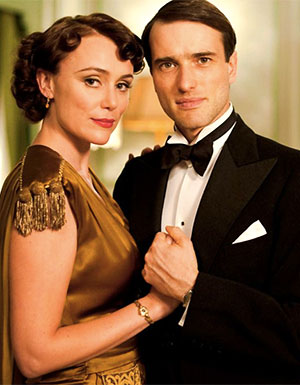We just can’t seem to get enough of the ‘have and have-not’ story. “Downtown Abbey” may be the best known “above and below stairs” drama, but before “Downton,” there was “Upstairs, Downstairs.”
Twice.
To help keep this site running: Willow and Thatch may receive a commission when you click on any of the links on our site and make a purchase after doing so.
The period series premiered on British Television in 1971 and was resurrected in 2010 with a new, all-star cast, including Keeley Hawes and Ed Stoppard. Both mini-series take place in the early 1900s and focus on the lives of the occupants of 165 Eaton Place, a gracious townhouse in Belgravia in central London.
Some see the new version from BBC and Masterpiece as the superior watching experience, and others insist the original is the best. Below, Michelle Cox reviews both versions, and offers five points to consider, to help you decide which to watch. The good news: you can’t go wrong, and both are available to stream.
The Innovation
The original “Upstairs, Downstairs” was considered groundbreaking at the time of its release because there had never before been a drama series on British television that examined society from the servants’ point of view. London Weekend Television (LWT) held off on airing the first season – the network wasn’t convinced that the British public would be interested in a period series – and the executives nearly scrapped the show before finally giving it a 10:15 PM slot on Sundays.
The public loved it. “Upstairs, Downstairs” became the most popular drama series on TV at the time, picking up over twenty-five awards, including the rare Peabody Award and two BAFTA’s, during the course of its run (1971-1975).
The series was also a favorite with American audiences when it aired in the US in 1974. Viewers delighted in watching the intrigues of the aristocratic Bellamy family alongside the lives of the servants who served them. The period drama won several awards stateside, including eight Emmys and two Golden Globes, and was one of the highest-rated shows in PBS history.
Likewise, the newer version was innovative in it’s own way, as it was not just a remake of the original but instead moved the story forward in time with a whole new cast. What’s unusual is that it is the setting—the house—which remains in place, not the story or the characters.
The Talent
“Upstairs, Downstairs” was the brainchild of Jean Marsh and Eileen Atkins, two British actresses who came from working class backgrounds; both had parents who worked as servants.
Atkins (Queen Mary in The Crown) and Marsh (Mrs. Ferrars in Sense & Sensibility) had enjoyed the mini-series “The Forsyte Saga.” “But we said, ‘Yes, but our poor parents would have been ironing those frocks and blacking those grates and washing up all that stuff, and wouldn’t it be wonderful if there was a series about the downstairs people?’ And originally it was just going to be about downstairs. And then we realized you couldn’t have downstairs without upstairs so we had to let the rich people in.” (Eileen Atkins)
Marsh and Atkins’ first idea had been to create a comedy called “Behind the Green Baize Door” about a cook who drinks too much, and a butler who takes advantage of his employers. The project morphed into “Upstairs, Downstairs,” with Jean Marsh playing the role of Rose Buck, the parlor maid. Eileen Atkins was playing Queen Victoria in a stage play and had to forgo a role in the production. Years later, she was cast as Mrs. Croft, the head cook in “Gosford Park,” so she had her turn at playing a servant below stairs.
One face younger viewers may recognize from the 1970s series is Pauline Collins. Collins played the much-loved character of the maid Sarah, and went on to star in the “Upstairs, Downstairs” spin-off “Thomas and Sarah,” but period drama fans will more likely know her from her role in “Bleak House” as Miss Flite, or as Mrs. Baker in “Albert Nobbs,” and Mrs. Gamp in “Dickensian.”
When the series was rebooted in 2010, both Jean Marsh and Eileen Atkins took roles for the first season of the new period drama. Marsh returned as Rose Buck, now the head of an employment agency tasked with supplying 165 Eaton Place with a fresh crop of servants, and Atkins plays the eccentric mother-in-law.
Ed Stoppard (Home Fires) and Keeley Hawes (Mrs. Wilson) were recruited to play the new upstairs occupants, and they positively sizzle together. As fans of “The Durrells in Corfu” know, Hawes is well suited to a 1930s setting. She seems to have almost stepped out of the pages of a periodical of the day, not just in the style of her clothes and hair, but in demeanor. Claire Foy (The Crown), who plays the devious younger sister, Persie, particularly shines in her role. While Hawes’ character, Lady Agnes, is elegant and dutiful, Foy’s character practically shimmers in her naughtiness.
The House that Lives On
The five seasons of the original series are set between 1903 and 1930, moving through the Edwardian, First World War, and Interwar eras. The 2010 version picks up in 1936 with a continuation of the story of the house – 165 Eaton Place – but not a continuation of the original Bellamy family storyline.
No spoilers about how the original series ends and what happens to the family and the beloved servants below stairs, but the new series begins with a new family. Sir Hallam and Lady Agnes Holland take up residence in the now dilapidated 165 Eaton Place. When Lady Agnes sees the house for the first time, she proclaims “It’s like a fairy tale. This house is going to see such life!” Over the course of seasons, it does, but the irony is that it already has.
Viewers who watch both series will enjoy seeing the same set, though it was actually filmed in two different locations. For the original version, the exterior of the house was shot at 65 Eaton Place with a “1” painted on to indicate 165. The interiors, however, were shot at London Weekend’s TV studios on the South Bank. When it came time to film the new version, the producers chose Cardiff as a location, parts of which were altered to look like 1930s Belgravia in London, and the house’s exterior itself was shot at Leamington Spa in Warwickshire.
The Substance and the Style
Because of a technician’s strike in Britain, the first thirteen episodes of the original series were filmed in black and white. PBS decided against airing these episodes, assuming that American viewers wouldn’t watch a series that wasn’t in color.
The updated version is beautifully shot, and in the hands of Arwel Jones (Sherlock) and Eve Stewart (Call the Midwife), has a production value that we’ve come to expect from BBC and Masterpiece. The original series’ grainy quality and simple costumes have been replaced by gorgeous gowns from costume designers Amy Roberts (The Crown) and Ralph Wheeler-Holes (Call the Midwife), and opulent, detailed sets from Julia Castle (The King’s Speech) and Hannah Nicholson (Traitors). The newer version is lovely to look at, but some critics have negatively critiqued it, saying that the scripts are no match to the original.
The original version had the benefit of a longer run than the mini-series. Comprised of sixty-eight episodes, it was able to cover a large breadth of topics, with plot lines centering around historical events, such as the Jazz age, the sinkings of the Lusitania and the Titanic, the First World War, and the stock market crash. Over four years, the series developed deep intrigue between the characters, accentuating the acute distinctions between the worlds upstairs and down.
Plot lines in the updated version also revolve around real world events, such as the king’s abdication, Hitler’s rise to power, and the build up to the Second World War, but it is not afforded the space of time needed to completely explore the relationships between the characters in the same way that the first version does. The effect is that the stories of various characters seem to run in parallel, instead of being tightly woven together.
Both have compelling narratives, and as in many of our favorite period dramas, their story lines often revolve around relationships between the sexes. There’s romance, and lustful concupiscent attractions, both above and below stairs, and sometimes even between the two. As you’d expect, the upstairs occupants sometimes take liberties with the downstairs staff, though in the updated version, it is a woman above stairs who takes advantage of the chauffeur.
The Gender Question
Though over three decades pass, little changes for women between the start of the old, and the end of new, versions of “Upstairs, Downstairs.”
Below stairs, the role of women remain fundamentally the same from one series to the next with few exceptions. The female servants remain in harness, both versions have plot lines involving the thwarted dreams of maids who dare to reach for a better life.
The choices are not much better for the above-stairs women, who find themselves just as boxed in and optionless as the women servants below them. Both Lady Marjorie in the original series and Lady Agnes in the second are meant to be merely stunning accessories to their husbands. Their role is to facilitate their husbands’ careers by working the social strings in the background, and to fulfill their duty to produce children.
Both series provide insight into class-based societal expectations for women at the time. The original version shows this against the backdrop of the minor progress that was made in the first decades of the new century, such as women winning the vote. In the newer version, the coming war means that the women, both above and below stairs, are beginning to question the established norms.
The Decision
So which is best? Both versions have their strengths: the original as the forerunner to “Downton Abbey” with its revolutionary look at life above and below stairs, and the new version, picking up where the old left off, being generally easier on the eyes with a hit cast, gorgeous sets and attention to period detail. Can’t decide? Try both!
Watch Upstairs, Downstairs (1971)
Watch Upstairs, Downstairs (2010)
Michelle Cox is the author of the award-winning Henrietta and Inspector Howard series, including her latest, “A Veil Removed,” which is available here, April 30, 2019. It’s perfect for fans of “Downton Abbey” and historical mystery/romance. Cox holds a B.A. in English literature from Mundelein College, Chicago.
Michelle also pens the weekly Novel Notes of Local Lore, a blog dedicated to Chicago’s forgotten residents. She suspects she may have once lived in the 1930s and, having yet to discover a handy time machine lying around, has resorted to writing about the era as a way of getting herself back there. Coincidentally, her books have been praised by Kirkus, Library Journal, Publishers Weekly, Booklist and many others, so she might be on to something. Unbeknownst to most, Michelle hoards board games she doesn’t have time to play and is, not surprisingly, addicted to period dramas and big band music. Also marmalade.
If you enjoyed this post, be sure to see The Period Films List, with the best historical and costume dramas sorted by era. You’ll especially like the Best Period Dramas: Interwar Era List, and want to see the news about the Downton Abbey Movie.

